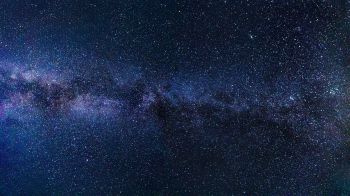
Our galaxy, the Milky Way
Physicists at the University of Sussex will be part of a global team of scientists creating a three-dimensional map of ten million galaxies neighbouring our own.
The "4MOST" project (4-metre Multi-Object Spectroscopic Telescope) is a collaboration with renowned institutions in the UK and abroad. First the team will add a new spectroscopic facility to the VISTA telescope at the European Southern Observatory in Chile, and then they will observe up to ten million galaxies as well as millions of Milky Way stars.
By looking at the spectral features of the light emitted from the centre of each galaxy, the team will be able to calculate how fast each galaxy is moving away from the Milky Way. As the universe is expanding at a uniform rate, the speed of movement of a galaxy is an accurate proxy for its distance from us. Having located each of the galaxies the team will create a three-dimensional map of a significant volume of the universe.
This is one of the University of Sussex's largest astrophysics projects. The Sussex team includes Dr Jon Loveday, Prof Seb Oliver, Prof Kathy Romer and Dr Robert Smith as well as numerous students and other researchers.
Dr Jon Loveday, a Reader in Astronomy in the School of Mathematical and Physical Sciences, who is leading the project for the University of Sussex, says:
"We will be creating a 3-D map of ten million galaxies in the sky, viewing them from a telescope in Chile. Not only is this an important and fascinating endeavour in its own right, but it may also help us to understand what the universe is made of. We know there are such things as 'dark matter' and 'dark energy' which are responsible for the way the universe formed and is expanding - but we still don't know what they actually are. Sussex scientists working on this project will be therefore trying to unlock some of the greatest mysteries of the universe."
PhD student Dan Pryer who has already started working on the project, on the 'extragalactic helpdesk', says:
"As a student it's really exciting to be able to work on a project like this. I've also volunteered on the 'extragalactic helpdesk', which might sound like a call centre for aliens (!), but it actually sees me working with researchers around the world on surveys of galaxies in space. I think it will allow me to develop my communication skills and also network within the scientific community which might help me in the future."
Professor Philip Harris, Head of the School of Mathematical and Physical Sciences, said:
"We're thrilled to have joined the highly prestigious 4MOST consortium in leadership roles, as this will help to keep the University of Sussex at the very forefront of the next generation of UK astronomy. It is tremendously exciting, and amongst other things, it will give our staff and students the opportunity to help create a three-dimensional map of the universe with unparalleled resolution, shedding light on some of the greatest outstanding questions about our cosmic origins."
The 4MOST project is due to begin taking observations in 2022 and will run for at least five years.






